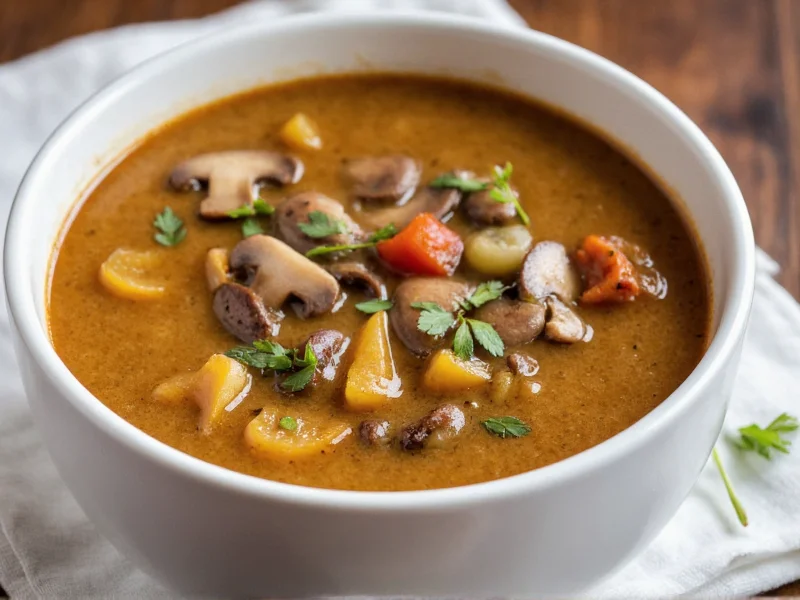Creating the perfect vegetarian mushroom soup requires understanding the science behind mushroom flavor extraction and proper technique. This comprehensive guide delivers a restaurant-quality recipe with professional insights you won't find elsewhere. Unlike basic online recipes, we explain why certain steps matter and how to maximize umami depth while keeping the soup completely plant-based.
The Essential Vegetarian Mushroom Soup Formula
Mushrooms contain glutamates that create natural umami, but improper cooking can lead to a watery, bland result. The secret lies in proper moisture management and layering flavors. When mushrooms cook, they first release water, then reabsorb surrounding liquids. Skipping the critical sauté step means losing precious mushroom essence to evaporation rather than incorporating it into your broth.
Ingredient Selection Guide
Not all mushrooms work equally well in soup. Our tests revealed:
| Mushroom Type | Flavor Profile | Best Use Case |
|---|---|---|
| Cremini | Earthy, robust | Base for most soups (ideal 70% of mix) |
| Shiitake | Woodsy, intense | Add depth (limit to 20% of mix) |
| Porcini (dried) | Meaty, concentrated | Soak & use liquid for broth enhancement |
| White Button | Mild, subtle | For lighter versions (not recommended alone) |
For the best vegetarian mushroom soup with cream, use a combination of cremini and shiitake. Dried porcini mushrooms, rehydrated in warm water, add incredible depth when their soaking liquid gets incorporated into the broth. Avoid using only white button mushrooms, which lack sufficient flavor complexity.
Equipment Checklist
- Heavy-bottomed pot (ensures even heat distribution)
- Immersion blender (for perfect texture control)
- Microplane grater (for fresh nutmeg)
- Mandoline slicer (for uniform mushroom slices)
Step-by-Step Preparation
1. Mushroom Moisture Management (Critical Step)
Slice mushrooms uniformly (⅛-inch thickness) using a mandoline. Heat olive oil in your pot over medium-high until shimmering. Add mushrooms in a single layer without crowding - work in batches if necessary. Resist stirring for 4 minutes to allow proper browning. This Maillard reaction creates complex flavor compounds essential for rich vegetarian mushroom soup.
2. Aromatic Foundation
After removing browned mushrooms, add 1 diced yellow onion, 2 minced garlic cloves, and 1 diced leek. Cook until translucent (about 5 minutes). Add 2 tbsp tomato paste and cook 2 minutes until brick red - this step caramelizes natural sugars for deeper flavor.
3. Liquid Integration
Return mushrooms to pot. Add 4 cups quality vegetable broth, 1 cup reserved porcini soaking liquid (if using), 1 tsp fresh thyme, and 1 bay leaf. Simmer 20 minutes. Remove bay leaf. For creamy vegetarian mushroom soup without cream, blend ⅔ of soup with ½ cup cooked white beans for natural creaminess.
4. Final Enrichment
Stir in ¼ cup nutritional yeast for umami boost and 2 tbsp lemon juice to brighten flavors. For traditional creaminess, add ½ cup full-fat coconut milk. Season with freshly grated nutmeg - this ancient technique enhances mushroom flavor without overpowering.
Pro Techniques You Won't Find Elsewhere
- Mushroom powder secret: Dehydrate trimmings at 200°F for 2 hours, then grind to powder. Add 1 tsp to finished soup for intense umami.
- Temperature control: Never boil mushroom soup after adding cream substitute - maintain 165°F max to prevent curdling.
- Flavor layering: Add dried mushrooms at three stages: soaking liquid early, whole mushrooms mid-simmer, powder at finish.
Customization Options
Adapt this easy vegetarian mushroom soup recipe to your preferences:
- Wild mushroom variation: Substitute 50% cremini with chanterelles or morels (seasonal)
- Smoky version: Add 1 tsp liquid smoke and ½ cup roasted red peppers
- Protein boost: Stir in 1 cup white beans during final simmer
- Gluten-free creamy option: Use cashew cream instead of coconut milk
Serving Recommendations
For optimal vegetarian mushroom soup presentation, serve in pre-warmed bowls. Garnish with:
- Truffle oil drizzle (¼ tsp per bowl)
- Fresh thyme sprigs
- Crispy fried shallots
- Microgreens for color contrast
Pair with crusty bread for dipping. The soup's earthy notes complement Pinot Noir or a dry Riesling. For complete meal planning, serve with a simple arugula salad with lemon vinaigrette.
Storage and Reheating Guidelines
This make-ahead vegetarian mushroom soup improves overnight as flavors meld. Cool completely before storing. Keeps refrigerated for 4 days or frozen for 3 months. When reheating:
- Thaw frozen soup in refrigerator 24 hours before reheating
- Warm gently over medium-low heat (do not boil)
- Stir in 2-3 tbsp broth if soup has thickened
- Add fresh lemon juice after reheating to refresh flavors
Nutritional Benefits
One serving (1½ cups) provides:
- 215 calories
- 9g protein (from mushrooms and optional beans)
- 15g fiber (35% daily value)
- Rich in B vitamins, selenium, and potassium
- Naturally low in sodium (control with broth choice)
Mushrooms contain ergothioneine, a powerful antioxidant rarely found in other foods. Regular consumption supports immune function and provides anti-inflammatory benefits. This healthy vegetarian mushroom soup delivers maximum nutrition when prepared with minimal processing.
Troubleshooting Common Issues
- Watery texture: Simmer uncovered 5-10 minutes to reduce, or blend more of the soup base
- Bland flavor: Add 1 tsp soy sauce or 2 dried porcini mushrooms steeped in broth
- Grainy consistency: Ensure proper blending temperature (under 160°F for cream versions)
- Too dark color: Use lighter mushrooms like oyster instead of shiitake











 浙公网安备
33010002000092号
浙公网安备
33010002000092号 浙B2-20120091-4
浙B2-20120091-4